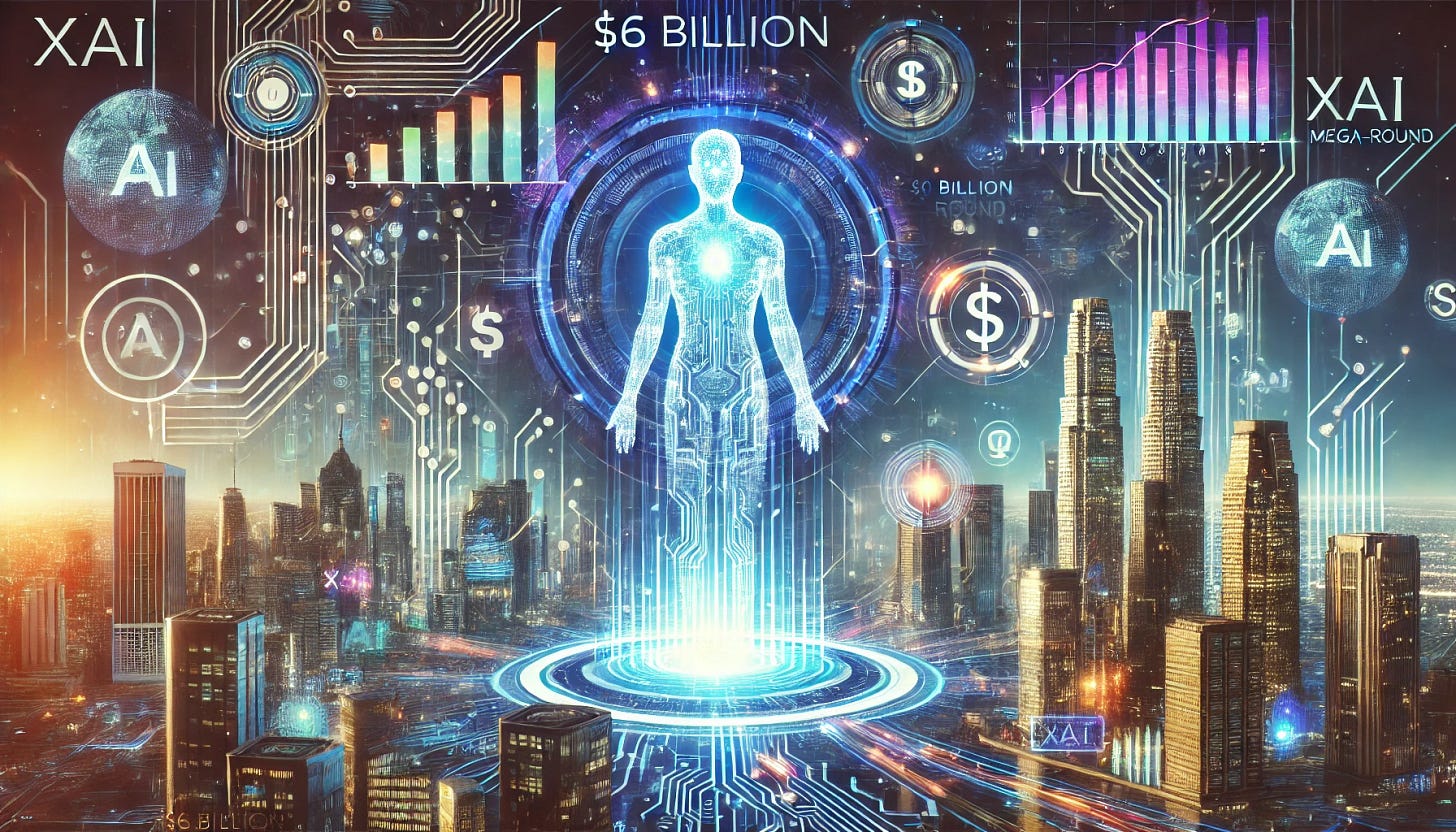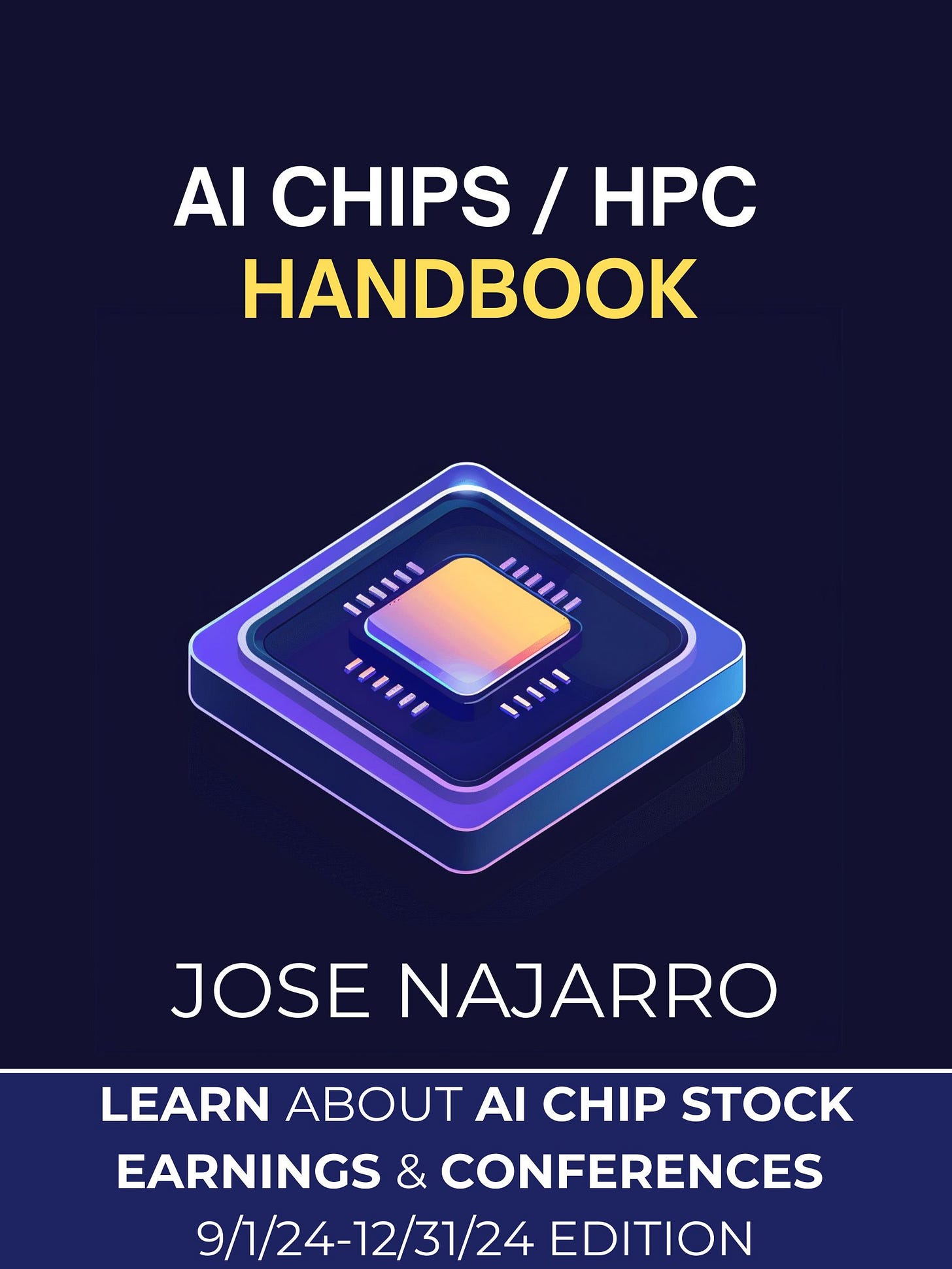Welcome, AI & Semiconductor Investors.
xAI’s $6B mega-round solidifies its vision of shaping the next AI horizon, with heavyweight backers turbocharging their push to reinvent AI infrastructure.
Curious how Meta’s rumored 2-gigawatt data center spree and Apple’s Vision Pro pivot might reshape the AI and XR landscape? --- Let's find out...
What The Chip Happened?
🚀 xAI’s $6B Mega-Round: Fueling the Next AI Frontier
💀 AI Scaling’s Not Dead!!
👓 Vision Pro Sets a New Standard: From Entertainment to Work
Read time: 7 minutes
xAI (Private) Nvidia (NASDAQ: NVDA) Advanced Micro Devices (NASDAQ: AMD)
🚀 xAI’s $6B Mega-Round: Fueling the Next AI Frontier
What The Chip: xAI just announced a massive $6B Series C fundraise from a star-studded list of backers including A16Z, Blackrock, Morgan Stanley, and strategic partners NVIDIA and AMD. This blockbuster round accelerates xAI’s infrastructure expansion, setting the stage for next-gen AI breakthroughs.
Details:
🔥 Huge Series C: xAI’s new $6B raise follows its Series B in May 2024, marking a rapid upswing in financial backing for frontier AI development.
⚙️ Colossus Scaling: The company’s supercomputer, powered by 100,000 NVIDIA Hopper GPUs, is already live—xAI plans to double its capacity to 200,000 GPUs in record time.
💻 AMD & NVIDIA Onboard: Beyond capital, these semiconductor heavyweights are likely looking to gather real-world AI workload insights—an investment that could help refine their next-gen chips.
🏆 Frontier LLM: Grok 2 is already pushing state-of-the-art language capabilities, and Grok 3 is in training. Expect cutting-edge multi-modal capabilities and real-time understanding through partnerships with X (formerly Twitter).
💡 New Offerings: The xAI API provides developers with easy access to foundation models. Aurora, xAI’s image generation model, adds sophisticated editing features for developers and creatives.
✨ Strategic Investors: Along with venture stalwarts like Sequoia Capital and Lightspeed, major funds like Fidelity Management & Research are fueling xAI’s global ambitions.
🎙️ Quote from xAI: “We aim to build truthful, competent AI that benefits all of humanity,” a spokesperson shared, emphasizing xAI’s mission to accelerate AI innovation responsibly.
Why AI/Semiconductor Investors Should Care: NVIDIA and AMD’s participation isn’t just about funding—it’s about securing front-row access to cutting-edge AI workloads, data, and engineering feedback. With xAI’s rapid hardware expansions, the insights gleaned could inform next-generation chip designs and market strategies, potentially shaping how we power the AI services of tomorrow.
Moore Semiconductor Investing
📗 Unlock Q3 Semiconductor Earnings --- 50% OFF
What The Chip: Get a front-row seat to the financials shaping the semiconductor industry. This continuously updated e-book by Jose Najarro distills the latest quarterly insights—from wafer production trends to AI chip breakthroughs—into a single comprehensive resource.
Details:
🔵 Dynamic Updates: Start with giants like TSMC and ASML, then expand to 30+ companies as their Q3 2024 earnings roll in. Already covering over 30 companies.
🔵 Huge Value for Half the Price: For a limited time, the e-book is discounted from $49.07 USD to $24.54 USD, offering a robust market guide at a significant value.
🔵 Expert Analysis: Curated by Jose Najarro (Master’s in Electrical Engineering, contributor at The Motley Fool), delivering reliable, accessible breakdowns.
🔵 Key Metrics & Trends: Follow critical financial indicators, market shifts, and executive comments shaping the sector’s trajectory.
🔵 Broad Coverage: From traditional chipmakers to cutting-edge AI semiconductor players, get the full picture as it emerges.
Why AI/Semiconductor Investors Should Care: This evolving earnings handbook gives you a strategic edge. Understanding quarterly earnings data is crucial for gauging industry health, discovering new growth leaders, and aligning your investment approach with emerging technological waves.
Disclaimer: For educational and informational purposes only. Not financial advice. Consult with a qualified professional before making any investment decisions.
Various CSPs and Semiconductor Companies
💀 AI Scaling’s Not Dead!!
What The Chip: Podcast BG2 had a wide-ranging conversation featuring Dylan Patel from SemiAnalysis, a compelling point emerged: if scaling large AI workloads were truly “over,” then why would Meta be building a rumored 2-gigawatt data center in Louisiana? Coupled with Amazon, Google, and Microsoft all pursuing multi-gigawatt mega-sites, it’s clear the hyperscalers still believe bigger is better for advanced AI development.
Details:
🔥 Mega Data Centers: Meta, Microsoft, Amazon, and Google are on a spree—snapping up gigawatts of power capacity. Their plan? Interconnect these sites with ultra-high-bandwidth fiber, effectively treating them as one massive “super data center.”
💡 Data Center Constraints: Dylan Patel highlights power availability—not just GPUs—as a bottleneck. When you’re scaling to 2 gigawatts, electricity, cooling, and infrastructure are just as critical as the silicon itself.
🏗️ Pre-Training vs. Inference Boom: Even if pre-training flattening is debated, “inference-time reasoning” grows cluster needs. More tokens, more memory, and more compute equate to bigger buildouts.
♻️ Why Keep Scaling: Dylan Patel notes that advanced AI tasks—like large language model pre-training and inference-time “reasoning”—are ballooning compute demands. Hyperscalers see real ROI in going big.
💻 GPU vs. Custom Silicon: While NVIDIA dominates, Google’s TPU and Amazon’s Tranium are robust in certain workloads. Still, the must-have factor is super-fast memory, networking, and software—areas NVIDIA has polished for years.
🎙️ Quote from Dylan Patel: “Is scaling over? No. Look at where the biggest players deploy capital. They’re not building 2-gigawatt sites just for show.”
🌐 CapEx Surge: Microsoft, Amazon, and Meta’s planned expansions suggest that official street estimates may be too low. Hyperscalers foresee massive AI-driven revenues justifying heavy spending.
⚖️ Spending vs. Revenue: Some worry these mega-capex strategies could be a bubble. But Microsoft, Meta, Google, and Amazon all see rising revenues from AI-based products and services—enough, they believe, to justify the gamble on scale.
Why AI/Semiconductor Investors Should Care: If the largest tech companies are pumping billions into mega data centers, it signals ongoing demand for high-end chips, advanced memory, networking gear, and innovative cooling solutions. As AI models become more complex and use more tokens, hardware requirements will skyrocket—and that can translate into multi-year tailwinds for well-positioned semiconductor and infrastructure players.
Apple (NASDAQ: AAPL)
👓 Vision Pro Sets a New Standard: From Entertainment to Work
What The Chip: According to TrendForce, Apple’s new Vision Pro has kickstarted a shift in the VR/MR market—beyond gaming and entertainment—toward productivity, collaboration, and even healthcare applications. Despite its high price, the Vision Pro captured a quick 5% market share in 2024, pushing others to reevaluate their device strategies and technical specs.
Details:
🎉 Meta Still Reigns: Meta commands the market with a massive 73% share, largely thanks to the US$299 Quest 3S. The company has postponed high-end offerings in favor of budget-friendly devices, fueling a steady rise in shipments.
🎮 Sony’s Struggle: PS VR2 lands second place at 9%, but limited functionality and PC integration dampened shipment volumes, down 25% YoY.
🍎 Apple Vision Pro’s Debut: Grabbing 5% share in its first year is no small feat, yet the Vision Pro’s expensive price tag and initially narrow app library led to slower-than-usual adoption for an Apple launch.
🔑 Value Pricing Matters: Meta halting Quest Pro 2, alongside Vision Pro’s premium approach, proves that affordability is key for large-scale consumer uptake. As a result, LCD remains the top VR/MR display tech at over 80% market share.
🏢 Productivity Leap: Vision Pro’s core advantage lies in reimagining VR/MR for business, from document editing and immersive meetings to professional sectors like healthcare. TrendForce sees this as a market-shaping pivot away from pure entertainment.
🖥️ OLEDoS Takes the Stage: Apple’s Vision Pro is the first VR/MR headset to adopt high-PPI OLEDoS microdisplays, setting a new bar for visual fidelity. This move could eventually push more brands to integrate advanced display solutions.
🚀 Apple’s Future Plans: Next-gen VR/MR devices could arrive by 2026, with two versions: one for premium users (likely still OLEDoS) and another more affordable variant, possibly using OLED or LTPO LCD for cost control.
Why AI/Semiconductor Investors Should Care: The VR/MR hardware race is expanding beyond gaming, tapping into corporate budgets and pro-grade applications. That means increased demand for high-performance silicon (including specialized displays and sensors), new software ecosystems, and hardware design innovations. For investors, following Apple’s dual-track approach—and how it pressures rivals like Meta and Sony—offers key insights into future growth opportunities across VR/MR and the broader extended reality space.
Youtube Channel - Jose Najarro Stocks
Semiconductor Q3 Earnings Book — 50% OFF
X Account - @_Josenajarro
Disclaimer: This article is intended for educational and informational purposes only and should not be construed as investment advice. Always conduct your own research and consult with a qualified financial advisor before making any investment decisions.






Format is all very "with the kids" and funky - but hard to read and understand.